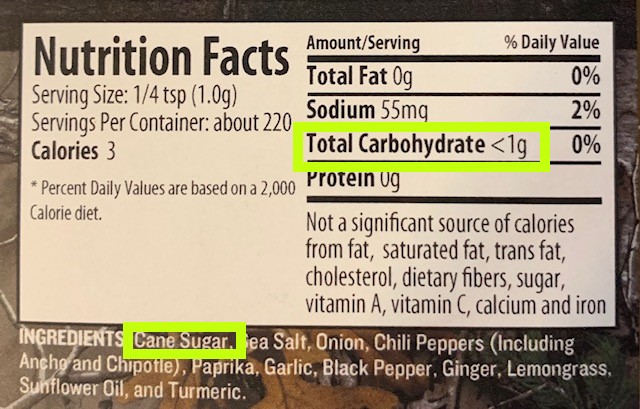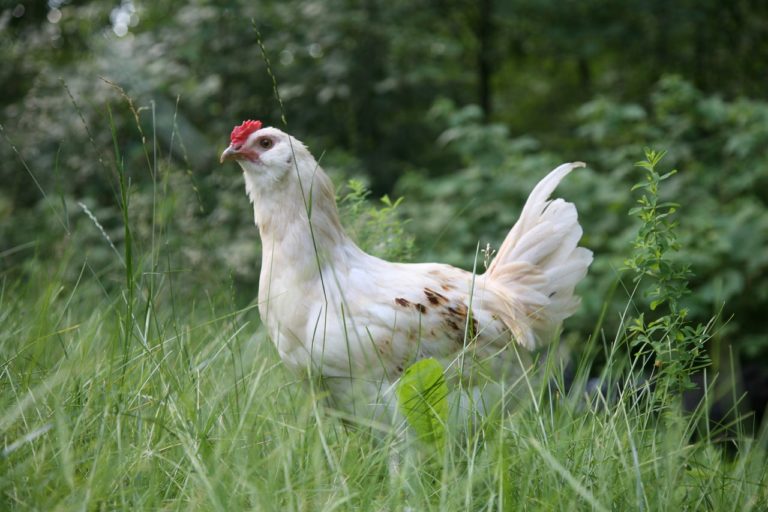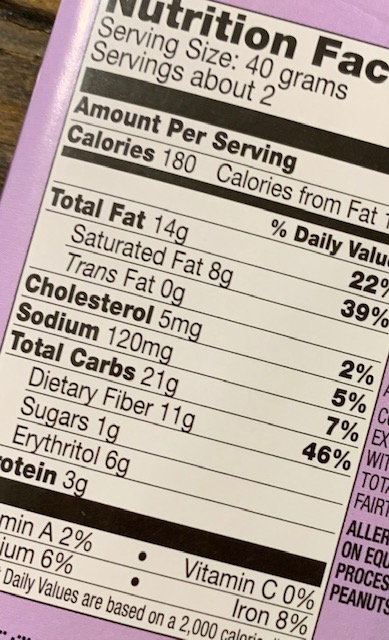Food Label Guide
By Lindsay // The Ketoneer
Navigating the world of food labels has become a skill that must be learned. We should not have to be so vigilant. We should not have to look at nutrition facts and ingredients on the back of packages to make sure the claims on the front of the package are substantiated. But that is the world we now live in. Products boasting sugar free all over the front of the packaging only to reveal it has one of the many “hidden sugar” names listed in the ingredients in tiny print. We should be able to believe brands. We should be able to trust them to be truthful in their labeling. That is unfortunately not how marketing works. I think stricter rules should be enforced in food labeling. But until the rules change (and I doubt they ever will), we must learn how to be more informed consumers.
Food Label Lies
Here are some big fat lies you need to be aware of when shopping. We would assume that nutrition labels list accurate amounts for things like carbs. Well, they don’t use the same rules for “rounding” that we were taught in school. Say something has 0.9 carbs. Reasonable people would think that should round up to 1 carb. Well, companies can still put zero carbs if it is anything less than one. I don’t know how many times I have seen the first ingredient in a listing as sugar, but the carb count is either zero or <1. Now, stop and think about this for a second. Ingredient listings go in order from most to least. So, if sugar is the first ingredient listed on a label, that means there is more sugar than anything else in that product. Do you think if a product is mostly made of sugar, that it could truly be low or zero carb? Nope, sorry. If something sounds too good to be true, it probaby is. See below for an example of this on a seasoning package.

Another strategy food companies use is creating small serving sizes. This is something else we have to check on the label. Sometimes companies will make their recommended serving size unrealistically small to make it look like the nutrition info is better than it really is. So, always stop and think, am I going to drink this whole bottle of this drink? Am I going to eat this whole cookie? Or just a fourth of this cookie like the label says I should? We have to account for serving sizes when tracking macros.



These next two lies I am going to discuss really make me angry. You may hear a lot of talk in the keto community about eating grass-fed meat and pasture raised eggs. The nutrition is normally better in these products. The animals are often treated more humanely in farms with these types of goals over factory farms/feed lots. You do pay a higher price for these products, so I always say buy the best quality food you can on your budget. If you can’t afford these things, that is okay and you can still do keto. Its still MUCH better than the processed boxed/packaged food we eat on the standard American diet. But also beware that meat labeled grass-fed, may not be grass-finished. Often the animal may be started on grass/hay then sent to a feed lot and fed grain prior to slaughter to fatten it up and make higher profit. Ruminant animals were meant to eat grass and when they are fed a diet unnatural for their species, like grain and soy, they become fat and sick (kinda like humans, see a trend?). Basically, there is little oversight on grass fed labeling. So, the company can sell it as grass-fed and charge you more money for the same feed lot meat on the discount shelf. We can’t rely on the USDA to stop this lying from happening on food labels. In 2016, the USDA dropped their claim standards for grass fed meat. I really wanted to believe this was false when I heard about it, but its right here on the USDA website. I say support local farms and ranchers as much as you can. Get to know the people running your local farmer’s markets. Get your food from honest farmers who care about the quality of their food if you can.
Now onto eggs. I used to buy “cage free” or “free range” eggs thinking I was really doing something great for my health and the environment. Supporting ethical farming. I then learned that factory farms can cram a bunch of chickens into a warehouse with a concrete floor and market them as amazing, wonderful “cage free” eggs. Same with the term “free range”. The USDA free range labeling only requires that birds have outdoor access, which means they may only have a tiny hole in the building and can’t even get outside. These conditions are often not much better than for factory farmed chickens who are stacked on top of each other in cages, never let free to roam on grass. Now, I spend the extra buck or two for the “certified humane pasture raised eggs”. These are the types of farms I am trying to support as much as I can. Again, I will only encourage you to do the best you can with your budget and what is available in your local area. Pete and Gerry’s and Vital Farms are two of my favorite egg brands that are available in my local Kroger stores. Read more about deceptive egg labeling and what certified humane means HERE.
Calculating Net Carbs

How to calculate Net Carbs:
Total Carbs – (minus) Dietary Fiber – (minus) Erythritol or Sugar Alcohols = Net Carbs
As I discussed in my previous blog, the only sugar alcohol I am going to recommend you subtract from your carbs is erythritol. If you look at the label above, I would count that as 4 Net Carbs in one serving, which is half of this Lily's chocolate bar. This can be confusing as some brands will list it as erythritol on the label and some will list it as sugar alcohol. You always need to scan the ingredients and see what sugar alcohol is listed. I do not recommend consuming sugar alcohols like maltitol or sorbitol on a regular basis. And if you do consume them, I do not recommend you subtract those sugar alcohols from your carbs as they can still spike your blood sugar. Please see my previous blog post for my thoughts on sugar alcohols and sweeteners.
People ask me how many net carbs they need to eat on keto. Twenty is a number I generally recommend. If you stay under 20 net carbs per day, there is a pretty good chance you will be in ketosis range. Men can sometimes get away with a little more than women, like 30 to 50. But unless you are checking your ketone levels, there is no way to truly know your exact limit. I don't check my ketone levels and do not think it is necessary. I say just shoot to stay around 20 and you should be good to go.
Again, please try to always buy real, whole foods as your main diet staples. You will avoid a lot of the food label confusion when you stick to things like meat and broccoli. If you pick up an avocado in the produce aisle, the only ingredient is….that’s right, avocado. There is no food label to even read.
I know all of this can be confusing, so feel free to leave your questions below. I hope this blog will help you navigate the murky waters of food labels.
